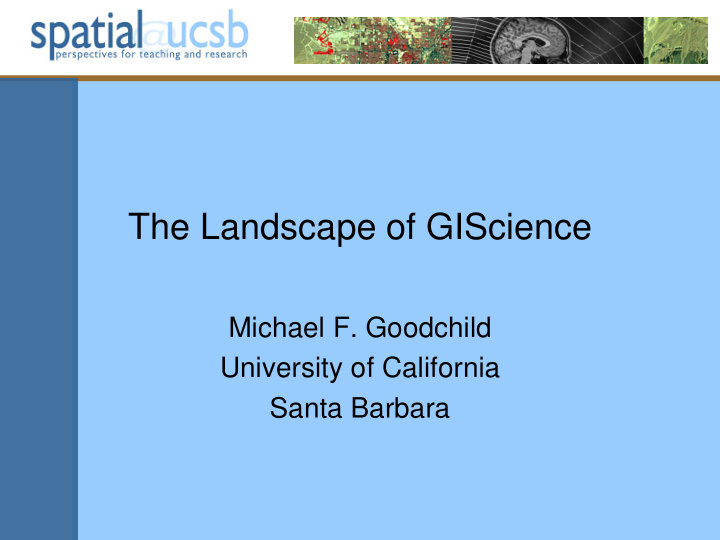



The Landscape of GIScience Michael F. Goodchild University of California Santa Barbara
GIScience • The systematic study of the fundamental issues – raised by geospatial technologies – implemented in geospatial technologies – what one thinks about when using them • How well does the database (the map) represent the real world (the territory)? – “the map is not the territory” (Korzybski, 1931) • The knowledge that helps us to build these technologies
What’s in a name? • GIScience as a 1992 play on “GIS” – spatial information science • Data vs information – “information is data fit for purpose” • GIScience as a subset of IScience? – GDScience or SDScience as a subset of DScience? – personally I would prefer the G to be primary and data science the subset • “digital geography” perhaps? – the science of where?
1. Data management • Curation – generic or domain-specific? https://www.nap.edu/catalog/18 590/preparing-the-workforce- for-digital-curation
More data management • Metadata standards • Framework data sets • Data sharing • Standards for data formats, structures, models
Why the fuss? • What is special about spatial? – why should GIScience be taught in a university? – why is it more than making maps? • and making maps is far from trivial • 2. What are its principles?
Some principles • The results of any spatial analysis change when the units of analysis change – cancer and counties – the Modifiable Areal Unit Problem • Generalization from one geographic area to another is always problematic – spatial heterogeneity
Tobler’s First Law of Geography • Nearby things are more similar than distant things – the principle behind spatial interpolation, contour mapping, regions • Anomalies are interesting – hot spots, cold spots – high surrounded by low, low surrounded by high • Geographic information will always lead us to question the basic assumptions of inferential statistics
3. Ethics • Early critique of GIS, 1988-2000 – simplistic representations – fails to recognize its military/intelligence roots – empowers the already powerful – invades individual privacy • Rapprochement, 1995-now – PPGIS – GIS 2 – Alt-GIS – Critical GIS
4. The changing landscape • Big data – finer spatial and temporal resolution – new interest in dynamics – new variables, methods – faster computation – new questions • Consumerization – crowdsourcing – neogeography – places over spaces
Big data volumes in GIScience? • Landsat since 1972 • 30m pixel for TM, 8 bits or 1 byte per band • 500 x 10 12 sq m of Earth surface • 500 x 10 9 pixels • 4 bands • 2 x 10 12 bytes per Earth coverage • 1 coverage every 19 days • 20 coverages per year = 4x10 13 bytes per year for 40 years • 1 petabyte from Landsat TM
18
How has science dealt with massive volumes of geospatial data? • Analysis of Landsat – download, analyze each scene separately – hope that your area of interest lies entirely within one scene – hope that interactions of interest don’t extend across scene boundaries • Divide and conquer – a classic approach to dealing with data volume
Downside of divide and conquer • Missing long-distance effects that span scenes • How to generalize from analysis of one scene? – spatial heterogeneity
Transitory, for one user only right now Synthesized from numerous inputs including VGI Point-of-interest, street centerline databases
St-Exupéry, The Little Prince • “It is not the geographer who goes out to count the towns, the rivers, the mountains, the seas, the oceans, and the deserts. The geographer is much too important to go loafing about. He does not leave his desk. But he receives the explorers in his study. He asks them questions, and he notes down what they recall of their travels.”
The Fourth Paradigm • “Let the data speak for themselves” – data-driven science • But geospatial data are never geography – it is impossible to measure location perfectly – all geospatial data are subject to a myriad of uncertainties, some are not replicable – generalized, abstracted, synthesized – detail is always truncated • When the data speak for themselves they do not speak for geography
Summary points • Spatial is special – but many developments in GIScience are not actually domain-specific • Coordinates in space-time open a vast array of possibilities – based on context • site and situation – based on distance, interpolation – spatially explicit analysis, modeling – more than any other set of two/three/four attributes
More summary points • If data science is about prediction – then space and time enable prediction of where (and when ) • Current interest in data science is an opportunity for GIScience – carpe diem
Recommend
More recommend